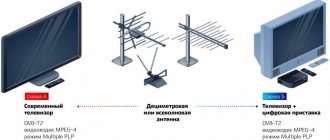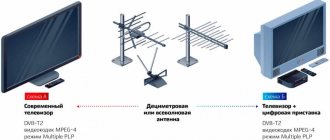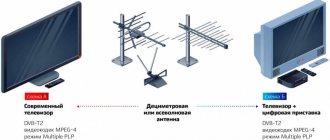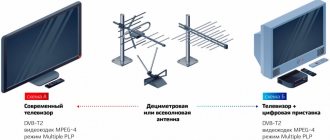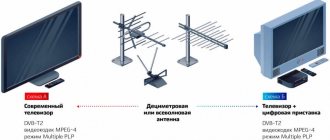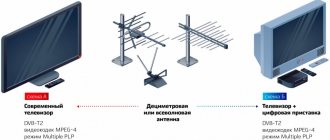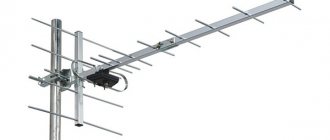How to set up and connect digital TV on a TV in Murmansk
Since January 2019, Russia and its regions have been switching from analogue to digital television signals in several stages. This allows you not only to improve the quality of image and sound, but also to increase the number of free channels. Finally, all settlements in Russia, according to information from representatives of the Ministry of Digital Development, Communications and Mass Communications of the Russian Federation, will be able to switch to digital before October 14, 2021. We will tell you what actions need to be performed at home or in the country when your region completely switches to digital TV.
In connection with the mentioned transition to digital broadcasting, those people who watch TV through an antenna, in some cases need to tune in to receive a digital signal. How can I tell if my television is digital or not? If, when you turn on the TV, instead of the usual TV programs you see a video about how to switch to digital, then you have analog television, and you need to perform a number of actions. The absence of an information video means that: you initially have digital television (satellite or Internet TV); you have terrestrial television, but the transition to digital broadcasting has already been completed; Do you have cable TV? The authorities agreed with cable television operators to preserve analogue broadcasting in the cable. But if you want, you can also switch to digital broadcasting in cable. Please note: if you have several TVs at home or in the country, they can receive a TV signal in different ways. For example, in the living room the TV is connected to cable TV, and in the kitchen the reception is via an antenna. How to set up digital TV at your dacha? Before the start of the summer season, we recommend that you find out in advance what type of signal the TV receives in your country house. If you have satellite TV, you don't need to do anything. But if you receive a TV signal using an antenna, prepare in advance to switch to digital TV. How to set up digital if I watch TV through an antenna?
If you have analogue television (there is an “A” next to the central channel logos), find out whether your TV supports the DVB-T2 standard. Digital TVs released after 2012 mostly have a corresponding decoder; those released earlier may not support this format (this is especially true for older analog TVs). You can check whether your TV supports the DVB-T2 standard in the instructions for the TV or using the “Search for information about TV” service on the website of the Russian Television and Radio Broadcasting Network (RTRS). You will need to enter the make and model of your TV. If your TV supports DVB-T2, you just need to set up your TV using the remote: Step 1: Turn off the TV's power. Step 2: Connect the antenna cable to the antenna input of your digital TV. Step 3: Connect the power and turn on the TV. Step 4. Go to the appropriate section of the TV settings menu and activate the digital tuner. Step 5. Automatically search for programs using the instruction manual. You can perform a manual channel search. In this case, you must enter the channel number or frequency. If your TV does not support this format, you need to purchase additional equipment - a digital set-top box (receiver). If you have two TVs that you watch through an antenna, and you want to watch different channels on them, you need to purchase a set-top box for each of them. The digital set-top box needs to be connected to the TV and configured: Step 1. Turn off the power to the TV. Step 2. Connect the antenna cable to the antenna input of the digital set-top box. Connect the video and audio cables to the appropriate jacks on your TV and set-top box. The image quality will be higher when connecting the set-top box to the TV with an HDMI cable. Step 3: Connect the power and turn on the TV. Step 4. From the menu, select the required input source: HDMI, AV, SCART and others. Step 5. Automatically search for digital TV programs using the operating instructions. You can perform a manual search. In this case, you must enter the channel number or frequency. You can also find more information on how to connect digital TV, choose a digital set-top box, where to buy it and how to set it up, on the website of the mentioned Russian Television and Radio Broadcasting Network (RTRS), where, depending on your region, you must call the hotline They will tell you how to troubleshoot possible problems. How can I retune my TV to digital if I have cable TV? If you have cable television and want to set up a digital signal, you need to: Step 1. Enter the menu using the special button on the remote control. Step 2. Go to the “Channel” section, which usually has a satellite dish icon. Step 3. Select "Auto search". Step 4. Select “Cable” from the proposed connection options. Step 5. Next, select “Digital” and click on “Start”. Step 6: If you want to keep the analog channels, select “Analog and Digital”. If you have any additional questions, you can contact your operator's support team. Please note: if you receive a TV signal through cable, but still see an informational video about switching to digital broadcasting, you will need to contact your cable operator's customer service and ask about how you can connect to digital TV within the current tariff. What channels will be available to me after switching to digital TV? If you watch television through an antenna, after switching to a digital signal, 20 mandatory TV channels of the first and second multiplexes will be available to you. The first multiplex includes: Channel One, “Russia 1”, “Match TV”, NTV, “Petersburg - Channel Five”, “Culture”, “Russia 24”, “Carousel”, OTR, “TV Center - Moscow”. The second multiplex includes: REN TV, Spas, STS, Domashny, TV-3, Friday!, Zvezda, Mir, TNT, Muz-TV). If you have cable television, you will have access to those channels that are provided for in your agreement with the operator. At the same time, by agreement between regional authorities and operators, more than 50 TV channels will be available in digital quality, the mos.ru portal reports. Earlier, the Ministry of Telecom and Mass Communications approved a plan for a phased disconnection from analogue television and radio broadcasting in the constituent entities of the Russian Federation as part of the transition to digital in December 2021. The switch-off from analogue broadcasting was decided to be divided into three stages from January to June 2021, namely February 11, April 15 and June 3. During the first wave of transition to digital, analogue TV was replaced in the Penza, Magadan, Ryazan, Ulyanovsk, Tula, Yaroslavl regions, as well as in the Chechen Republic. On April 15, another 20 Russian regions switched from analogue to digital television broadcasting. Among those who switched from analogue to digital TV were Moscow, Moscow region, Kalmykia, Mordovia, Karachay-Cherkessia, Chuvashia, Kabardino-Balkaria, Stavropol Territory, Udmurtia, Yamalo-Nenets Autonomous Okrug, as well as Kemerovo, Amur, Ivanovo, Kirov, Kostroma, Kurgan, Lipetsk, Novgorod, Sakhalin, Tyumen regions. It was planned that the transition process would end with the third stage on June 3, when the remaining 57 regions would be transferred to digital. However, the Russian government decided to extend this period and transfer the remaining regions of Russia to digital in October 2021. “The main task that continues to face all regions, regardless of whether they find themselves in the third or fourth stage, is to by June 3, all the necessary work was done. It’s just that residents of some regions that belong to the fourth stage, if fully ready, will receive analog television for some time,” concluded the deputy head of the Ministry of Telecom and Mass Communications. TOTAL, in October 2019, all regions of Russia: Adygea, Altai, Bashkiria, Buryatia, Dagestan, Ingushetia, Kabardino-Balkaria, Kalmykia, Karachay-Cherkess Republic, Karelia, KOMI, Crimea, Mari El, Mordovia, Sakha (Yakutia), North Ossetia (Alania), Tatarstan, TUVA, Udmurtia, Khakassia, Chechnya, Chuvashia, Altai Territory, Transbaikal Territory, Kamchatka Territory, Krasnodar Territory, Krasnoyarsk Territory, Perm Territory, Perm Territory, Primorsky Territory, Stavropol Territory, Khabarovsk Territory, Amur Region, Astrakhan Region, Arkhangelsk Region , Belgorod region, Bryansk region, Vladimir region, Volgograd region, Vologda region, Voronezh region, Ivanovo region, Irkutsk region, Kaliningrad region, Kaluga region, Kemerovo region, Kirov region, Kostroma region, Kurgan region, Kursk region, Leningrad region, Lipitskaya region, Magadan region, Moscow region, Murmansk region, Nizhny Novgorod region, Novgorod region, Novosibirsk region, Omsk region, Orenburg region, Oryol region, Penza region, Pskov region, Rostov region, Ryazan region, Samara region, Saratov region, Sakhalin region, Sverdlovsk region, Smolensk region, Tambov region, Tver region, Tomsk region, Tula region, Tyumen region, Ulyanovsk region, Chelyabinsk region, Yaroslavl region, federal cities - Moscow, St. Petersburg, Sevastopol, Jewish Autonomous Okrug, Khanty-Mansi Autonomous Okrug, Yamal-Nenets Autonomous Okrug, Nenets and Chukotka Autonomous Okrug - will switch completely to digital television.
03.05.2019 12:52
Let's go digital
In Russia, analogue terrestrial television broadcasting is gradually being replaced by digital broadcasting. In many countries around the world, the outdated TV signal has already been completely switched off. Chairman of the Committee for the Development of Information Technologies and Communications of the Murmansk Region Timur Lapin told Vecherny Murmansk about how our region is switching to a digital format and what innovations await TV viewers.
– Deputy Minister of Digital Development, Communications and Mass Media of the Russian Federation Alexey Volin said that after January 14 next year, analogue television broadcasting in settlements where less than 100 thousand people live will begin to be switched off. Then it will be the turn of larger cities. That is, this will affect all settlements in the region except Murmansk? And when will Murmansk switch to digital?
– According to the latest information, the shutdown will be gradual, from February 11 to June 10, 2021. The corresponding decision was made at a meeting of the Government of the Russian Federation on November 15. The transition plan, indicating specific dates, was approved by the government commission on television and radio broadcasting on November 29. In the Murmansk region, the shutdown will begin on June 3, 2021. The word “transition” means that the state will cease to support analogue broadcasting, primarily financially. This will happen in accordance with the transition plan that has been discussed. For small towns, this almost automatically means turning off analogue broadcasting, since they are now mainly broadcasting only programs from state television and radio companies and this broadcasting is subsidized by the budget. There are no plans to ban analogue broadcasting - the calculation is that it will not be economically feasible for the television companies themselves.
At the same time, in cities with a population of more than 100 thousand people, analogue broadcasting is not subsidized by the state. The decision on whether to stop it or not will be made by television companies independently. Digital broadcasting has been operating in Murmansk since 2014; in another 90 settlements in the region, the opportunity to receive programs appeared after the launch of CETV facilities at various times until 2016. The last facility in Vidyaevo will be launched this year. That is, almost every resident can watch digital terrestrial television now.
– What is the difference between digital TV and analogue TV? Will an antenna upgrade be required for digital reception?
– Differs in the principle of signal coding. In much the same way that sound recorded on magnetic tape differs from digital sound in an MP3 player. Most people who currently watch analogue terrestrial television will not need an antenna upgrade. A regular UHF antenna is suitable for this.
– Will northerners notice a change in image and sound quality?
- You should notice. Analogue television, due to technology, could “display poorly” - ripple, go in stripes or double. This cannot happen with digital: if the signal is too bad, nothing will be visible. If the signal level is sufficient, the screen will have a clear picture without any interference. Of course, the difference will be more noticeable to owners of TVs with a large screen diagonal, which allow them to display high-quality video images.
— Which TVs will be able to receive federal digital channels without additional equipment, and which ones – only with it? What kind of equipment is this? Where can I buy it and how to install it?
– Without additional equipment, the signal will be received by televisions that have a built-in DVB-T2 signal receiver. Modern TVs are usually equipped with such a receiver. This information can be obtained from the seller. You can check your TV purchased over the last five years using the Internet by searching for its model number. Older TVs will most likely require the purchase of additional equipment - set-top boxes. A set-top box is a small device into which you need to connect an existing antenna (outdoor or indoor), and connect this device to the TV. The possible connection method must be checked in advance by studying the instructions for the TV. The principle is similar to connecting a VCR or DVD player. The most commonly used connectors, sold in all electronics stores, are composite connectors (known as “bells”) and the modern HDMI standard.
– What should those who use televisions of old models, including Soviet ones, do?
– It is important to note that in general the transition from analogue to digital will only affect those TV viewers who are currently watching an analogue broadcast signal. It will not affect TV viewers who watch cable television (M2S, Teletoriya, Nordnet, RS-Telecom and others), interactive television (Rostelecom, NetByNet, Transtelecom and others), satellite television (Tricolor-TV, NTV+ and others).
Those who currently receive an analog terrestrial signal on their antenna should do the following: 1. Check whether their TV can receive a digital terrestrial signal. If yes, just make the settings in the TV menu. And watch the “digital”.
2. If there is no built-in digital receiver, you need to purchase a set-top box. To do this, you need to find documents for the TV or at least familiarize yourself with all the connectors that it has (except for the antenna). It is better to photograph them, for example, on a mobile phone. After that, go to an electronics store and purchase a set-top box that can be connected to the connectors available on the TV. Connect the antenna to the set-top box, the set-top box to the TV. If necessary, call for advice on the single federal hotline number 8-800-220-20-02 (24 hours a day).
3. If the TV does not have any connectors for connecting external devices, that is, you cannot connect a VCR or DVD player there, then you need a new television receiver. Technical progress does not stand still, and such an old TV, alas, will only show an analog signal and only until its broadcasting stops. An alternative option for such viewers is to connect to a cable television operator, which transmits an analog signal over its network. But here you need to remember about the subscription fee. With the current average cost of services being about 250 rubles per year, this would be 3 thousand rubles. A new TV, which no longer requires an additional set-top box, can be bought for about five and a half thousand rubles (40 centimeter diagonal), eight and a half thousand rubles will cost a larger TV (60 centimeter diagonal), and 11 thousand rubles for a device with a diagonal of 81 centimeter. Draw your own conclusions.
– Which channels will become digital?
– Now it is difficult to imagine a television company that produces its television programs in a non-digital format, since all modern equipment operates on the basis of digital technologies. That’s why, perhaps, all channels are now digital. The format change occurs precisely during the broadcast of the signal, along the path of the program from the TV channel to the viewer. There are two packages in the state digital terrestrial television and radio broadcasting network (they are also called “multiplexes” because there are many channels in one package) - RTRS-1 and RTRS-2. The first includes 10 all-Russian mandatory public television channels, the list of which is determined by Decree of the President of the Russian Federation dated June 24, 2009 No. 715 (Channel One, Russia 1, Match TV, NTV, Channel 5, Culture, Russia 24 ", "Carousel", "Public Television of Russia", "TV Center") and three radio channels ("Radio Russia", "Vesti FM", "Mayak"). Yes, there is also a radio in the multiplex, however, to listen to it you need to turn on the TV. The second multiplex includes 10 more TV channels selected on a competitive basis (today these are Ren TV, Spas, STS, Domashny, TV-3, Friday, Zvezda, Mir , TNT and Muz TV).
Prepared by Elena GRIBOVA. Photo from the website of the government of the Murmansk region.
The iPhone technology has found admirers all over the world. There are kilometer-long queues for telephones. Repairing iPhones requires a lot of experience and special equipment. Contact real professionals who will take care of your iPhone. Advertising.
homyak:
30.11.2016 at 19:45
“Digital”: how much does it cost and is it worth it?
NOVEMBER 26, 2016
Pros and cons of free TV
Progress does not stand still, and Murmansk residents are gradually getting used to the new capabilities of technology.
Even people of retirement age, many of whom do not like modern technology, have begun to connect to free digital terrestrial television broadcasting.
After all, there is nothing complicated about connecting.
To switch to digital, you either need to have a modern TV or purchase a special set-top box.
And of course, the antenna.
But then you can watch 20 TV channels completely free.
The digital terrestrial television network throughout the country is being deployed by specialists (RTRS) within the framework of the federal program.
Some – 10, others – 20. But it’s free!
The program to introduce free digital television to the masses has been running in the city for three years now.
And, as it turned out, it has not only advantages in the form of the absence of a monthly fee, but also disadvantages. We'll tell you about them.
So, recently, “digital” subscribers living in the Leninsky and Pervomaisky districts began to complain that out of 20 promised channels they were showing only 10.
Specialists from the Murmansk Regional Radio Transmission Center (ORTPC) explained that this is due to the difficult terrain of the city.
All channels are distributed only by the main repeater on the Varnichnaya Hill, which covers the nearby part of the city.
The so-called “shadow” zones receive signals from other television towers located in Kola and on the western shore of the bay.
But they only broadcast 10 channels.
This decision was made in Moscow by the directorate of the Russian Television and Radio Broadcasting Network. This problem can only be solved in 2018, when a widespread shutdown of analogue television is planned.
As soon as this happens, people will be able to “catch” all 20 channels in all districts of the city.
In the meantime, to view the “digits”, specialists from the Murmansk ORTPC recommend that Murmansk residents living near the television center on Varnichnaya Hill use indoor antennas.
The rest need to use outdoor UHF antennas or connect to a common antenna on the roof of the house.
Here is another disadvantage of digital TV: after the transition to digital, you will have to forget about regional television news releases.
There is no technical ability yet to insert regional programs on the air of federal channels in the Murmansk region.
Experts say that the necessary equipment is incredibly expensive.
An application from our region for its supply has been sent to Moscow, but almost all the constituent entities of Russia are in this queue, so no one can even give an approximate time frame.
Your own TV master
In addition to problems with receiving 20 channels and watching local news, Murmansk residents are faced with extortion from private companies involved in connecting digital television, which is free for everyone.
There really is no subscription fee for digital, but if a person himself cannot buy the necessary equipment and connect it to the TV, he has to turn to specialists who provide such services.
Murmansk ORTPTS does not connect equipment.
The staff of the consultation center on Shmidta Street, 4a (telephone 69-59-59) will tell you exactly what will be needed for connection.
If tangled wires make you panic, you'd better call a professional.
But at the same time, you need to be as careful as possible when choosing a company or specialist who is ready to help you.
Enterprising companies charge 2-3 times more than any private telemaster, who will connect and configure all the necessary equipment for about 500 rubles.
If you decide to completely switch to digital television, do not forget to terminate your existing agreement with cable or satellite television operators.
And keep in mind that one set of “digital” equipment allows one TV to receive a TV signal.
If you connect two, they will show the same channel synchronously.
20 free channels available to digital TV subscribers:
Channel One, “Russia-1”, “Russia-2”, NTV, Channel 5, “Russia-K”, “Russia-24”, “Carousel”, Public Television of Russia, “TV”, “Spas”, “STS” , “Domashny”, “TV-3”, “Friday”, “Star”, “Mir”, TNT and “Muz-TV”.
TO THE TOPIC
According to the Decree of Russian President Vladimir Putin, the transition to digital broadcasting has been extended until 2021, and for settlements with a population of less than 100 thousand people - until 2019.
The digital terrestrial television broadcasting network throughout the country is being deployed by specialists from the Russian Television and Radio Broadcasting Network (RTRS) as part of the federal target program.
They also organize centers for consulting support for the population.
In Murmansk it is located at the address: st. Shmidta, 4a (phone 69-59-59).
There you can learn everything about connecting and setting up digital broadcasting, see what the necessary equipment and broadcast TV programs look like on the TV screen.
Pavel STEPANENKO, “Evening Murmansk”
photo -
Answer
